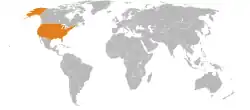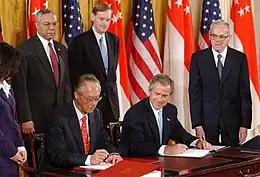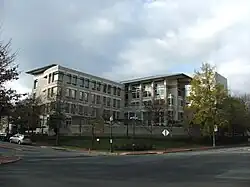 | |
Singapore |
United States |
|---|---|
| Diplomatic mission | |
| Embassy of Singapore, Washington, D.C. | Embassy of the United States, Singapore |
| Envoy | |
| Singapore Ambassador to the United States Lui Tuck Yew | United States Ambassador to Singapore Jonathan E. Kaplan |
.jpg.webp)
The Singapore–United States relations refers to the bilateral relations between the Republic of Singapore and the United States of America. According to the U.S. Global Leadership Report, 77% of Singaporeans approved of U.S. leadership under the Obama Administration in 2010, and while this approval rating decreased slightly down to 75% in 2011, it nonetheless remains one of the highest ratings of the U.S. for any surveyed country in the Asia-Pacific region.[1]
Despite the close relationship between the two countries, on 1 April 2022, Prime Minister Lee Hsien Loong stated that Singapore is not an ally of the U.S., will not conduct military operations on behalf of the U.S., and will not seek direct military support from the U.S.[2]
History
In 1961 the Singaporean government arrested two CIA agents who attempted to bribe a Singaporean official in exchange for providing information to the CIA. Prime Minister Lee Kuan Yew requested 35 million dollars in economic aid in exchange for the covert release of the two agents. The Americans rejected this offer however and presented a counter-offer of 3.3 million dollars to be given directly to Lee and the People's Action Party. The men were later released without any financial exchange. Lee revealed this incident in 1965 which led to the Americans to deny it ever occurred, however Lee later made public a letter of apology from the US Secretary of State Dean Rusk over the incident.[3][4][5]
The United States first opened a consulate in Singapore in 1836, when the island was part of the Straits Settlements of the British Empire. Singapore and the United States have maintained diplomatic relations since August 11, 1965, a few days after Singapore was expelled from the Malaysian Federation.[6] U.S. recognition of the new state was expressed in a first person diplomatic note sent to Singapore for delivery to the Foreign Minister; the note was read to the press in Washington. Department of State Bulletin, August 30, 1965, p. 357; Mark Feldman Oral History, Association for Diplomatic Studies and Training, p. 24. Singapore's efforts to maintain economic growth and political stability and its support for regional cooperation harmonize with U.S. policy in the region and form a solid basis for amicable relations between the two countries.[7]

From 1965 to 1975, the United States offered significant economic assistance to stabilise Singapore as a key segment of their containment of communism during the Cold War, and Singapore's economy industrialised through providing repair and transshipment facilities for the American forces in Vietnam.[8]
Hendrickson affair
E. Mason "Hank" Hendrickson was serving as First Secretary of the United States Embassy when he was expelled by the Singapore Government in May 1988.[9][10] Prior to his expulsion, he arranged for Francis Seow and Patrick Seong to travel to Washington, D.C. to meet with American officials.[11] After their return, Singapore detained them under the Internal Security Act.[12] Based on Seow and Seong's statements while in custody, the Singapore Government alleged that Hendrickson attempted to interfere in Singapore's internal affairs by cultivating opposition figures in a "Marxist conspiracy".[11] First Deputy Prime Minister Goh Chok Tong claimed that Hendrickson's alleged conspiracy could have resulted in the election of 20 or 30 opposition politicians to Parliament, which in his words could lead to "horrendous" effects, possibly even the paralysis and fall of the Singapore Government.[12]
In the aftermath of Hendrickson's expulsion, the U.S. State Department praised his performance in Singapore and denied any impropriety in his actions.[9] The State Department also expelled Robert Chua, a senior-level Singaporean diplomat equal in rank to Mason, from Washington, D.C. in response.[13][14] The State Department's refusal to reprimand Hendrickson, along with their expulsion of the Singaporean diplomat, sparked a protest in Singapore by the National Trades Union Congress; they drove buses around the U.S. embassy, held a rally attended by four thousand workers, and issued a statement deriding the U.S. as "sneaky, arrogant, and untrustworthy".[15]
A paper published by The Heritage Foundation speculated that Singapore's angry public reaction to the Hendrickson affair may have been a response to the January 1988 termination of Singapore's eligibility for the Generalized System of Preferences, which provided tariff exemptions on Singaporean exports to the United States.[13]
2018 North Korea–United States Summit

The latest meeting was held on 11 June 2018 between Prime Minister Lee Hsien Loong and President Donald Trump at the Istana before meeting North Korean leader Kim Jong Un the next day.[16]
Fields of relations
During the 2015 ASEAN Summit, when US President Barack Obama met Singapore Prime Minister Lee Hsien Loong, Obama described the state of bilateral relations as being "very, very strong".[17]
Free trade agreement

The United States and Singapore signed the Singapore–United States Free Trade Agreement on 6 May 2003; the agreement entered into force on 1 January 2004. The growth of U.S. investment in Singapore and the large number of Americans living there enhance opportunities for contact between Singapore and the United States. Singapore is a Visa Waiver Program country.[7]
The Singapore Government denied speculation that the signing of the FTA was linked to Singapore's support of the Iraq War coalition shortly before the signing.[18][19]
Military relations
.jpg.webp)
_leads_a_formation_followed_by_the_Republic_of_Singapore_Navy_(RSN)_frigate_RSS_Formidable_(FFS_68)_(48826767583).jpg.webp)
Singapore has long standing military relations with the United States. The United States sells arms to Singapore and provides access to its bases to train the Singaporean military outside of their small island city-state.[20] Under the U.S.–Singapore Strategic Framework Agreement, some U.S. Navy littoral combat ships are rotationally deployed to Singapore's Changi Naval Base.[21] Air Force One also lands at Paya Lebar Air Base whenever the president visits the country. On September 23, 2019, Singapore Prime Minister Lee Hsien Loong and US President Donald Trump renewed a key defence pact which allows American forces to use Singapore's air and naval bases, extending it by another 15 years to 2035.[22] On 1 April 2022, Prime Minister Lee Hsien Loong emphasised that Singapore is not an ally of the United States, Singapore will not be involved in a war of the United States or ask the United States to come to the rescue when something happens to Singapore.[2]
Relief operations
Following that devastation of the United States Gulf Coast by Hurricane Katrina, three Singaporean CH-47 Chinook helicopters and 38 RSAF personnel from a training detachment based in Grand Prairie, Texas, assisted in relief operations from 1 September. They ferried about 700 evacuees and hauled tons of supplies in 39 sorties on 4 September. One more CH-47 Chinook helicopter was sent to aid in relief efforts.[23][24]
Academic exchanges
In 2011, more than 4,300 Singaporeans were studying in the United States, the highest figure in 10 years. The number of Singaporean students studying in the United States grew by 7 percent since 2010. American universities with the most number of Singaporeans are among the most prestigious in the country which includes Harvard University, Cornell University, Stanford University, and University of California, Berkeley. To add to the rising number of college students study in the United States, many local students in Singapore have also opted to study in American high schools. US Ambassador to Singapore David I. Adelman said that the high number of Singaporeans studying in the United States reflects that Singapore–United States relations "have never been better".[25]
In 2012, Singapore and the United States signed a Memorandum of Understanding (MOU) to enhance collaboration in education between the two countries. This is the second MOU between the United States and Singapore on education. The first MOU signed in 2002 primarily focused on the teaching and learning of the Singaporean method of mathematics and science. The 2012 MOU have enhanced the teaching of mathematics and science, teacher development and school leadership, and educational research and benchmarking studies. In addition, the conference also announced that the National Institute of Education (NIE) in Singapore and Columbia University's Teachers College are launching a joint Masters of Arts in Leadership and Educational Change. This joint Masters programme will take in up to 30 students from January 2013.[26]
The U.S. government sponsors visitors from Singapore each year under the International Visitor Leadership Program (IVLP). The U.S. government provides Fulbright Awards to enable selected American professors to teach or conduct research at the National University of Singapore and the Institute of Southeast Asian Studies. It awards scholarships to outstanding Singaporean students for graduate studies at American universities and to American students to study in Singapore. The U.S. government also sponsors occasional cultural presentations in Singapore. The East-West Center and private American organizations, such as the Asia Foundation and Ford Foundation, also sponsor exchanges involving Singaporeans.[7]
Diplomatic representation

Singapore's chief diplomatic mission to the United States is the Singapore Embassy in Washington, D.C. It is further supported by many consulates located through the United States. The Singapore Government maintains consulates-general in several major U.S. cities including: Chicago, Miami, Houston, New York City[note 1] and San Francisco.[27]
The current Singapore Ambassador to the United States is Ashok Mirpuri.[27] Former United States Ambassador to Singapore, Steven J. Green, is Honorary Consul in Miami while the Former Chairman of the Federal Communications Commission, Newton N. Minow, is Honorary Consul in Chicago.[28][29]
The United States first opened a consulate in Singapore 1836, which was then part of the British Straits Settlements, appointing Joseph Balestier to the post of consul. The American embassy in Singapore was established on 4 April 1966, under chargé d'affaires ad interim Richard H. Donald.[6] Kirk Wagar most recently served as the U.S. Ambassador to Singapore from September 2013 to January 2017.[30][31]
Former Deputy US National Security Adviser K. T. McFarland was reportedly offered the ambassadorship,[32] but withdrew her nomination citing differences with the Trump administration. In September 2019, Trump nominated Barbera Hale Thornhill, president of Impact Design, a business-focused interior design firm in Los Angeles, California, as ambassador.[33] She too was never confirmed and withdrawn by his successor Joe Biden in February 2021.[34]
On 30 November 2021, Jonathan E. Kaplan was confirmed by the US Senate and sworn in as the US Ambassador to Singapore.[35]
See also
Notes
References
![]() This article incorporates public domain material from U.S. Bilateral Relations Fact Sheets. United States Department of State.
This article incorporates public domain material from U.S. Bilateral Relations Fact Sheets. United States Department of State.
- ↑ U.S. Global Leadership Project Report – 2011 Archived 2015-09-24 at the Wayback Machine Gallup
- 1 2 蓝云舟 Lan Yunzhou (10 April 2022). "李显龙总理:新美合作紧密不代表我国将涉入美国的战争" (in Chinese (Singapore)). Lianhe Zaobao 联合早报. Archived from the original on 10 April 2022. Retrieved 10 April 2022.
- ↑ Jeffries-Jones, Rhodri (2003). The CIA and American Democracy. Yale University Press. p. 150.
- ↑ Paget, Karen M. (2015). Patriotic Betrayal The Inside Story of the CIA's Secret Campaign to Enroll American Students in the Crusade Against Communism. Yale University Press. p. 346.
- ↑ Beyond Liberal Order States, Societies and Markets in the Global Indian Ocean. Oxford University Press. 2022.
- 1 2 U.S. State Dept. 2011
- 1 2 3 U.S. State Dept. 2009
- ↑ Daniel Wei Boon Chua (2017). US-Singapore Relations, 1965-1975: Strategic Non-alignment in the Cold War. NUS Press. pp. 163–164. ISBN 9789814722322.
- 1 2 Crossette, Barbara (1988-05-08), "Singapore Asks Removal of U.S. Envoy", The New York Times, retrieved 2010-03-03
- ↑ American Ambassador to Azerbaijan Anne E. Derse, USAID, 2007-07-06, archived from the original on 2009-05-17, retrieved 2010-03-03
- 1 2 Bellows 1989
- 1 2 "Hendrickson affair angers local leaders", New Sunday Times, 1988-05-10, retrieved 2010-03-11
- 1 2 Conboy 1989
- ↑ "What Lee said in 1964", The Economist, 1988-05-14, archived from the original on 2012-11-05, retrieved 2011-03-17
- ↑ "Singapore: Thousands Protest Expulsion", Eugene Register Guard, 1988-05-12, retrieved 2010-03-03
- ↑ "Trump says US-North Korea summit 'can work out very nicely', thanks PM Lee for hospitality".
- ↑ "The Straits Times – Singapore-US ties 'very, very strong': Obama". Government of Singapore. Archived from the original on 26 November 2015. Retrieved 25 November 2015.
- ↑ Jurgen Ruland, Theodor Hanf, Eva Manske (2016). U.S. Foreign Policy Toward the Third World: A Post-cold War Assessment: A Post-cold War Assessment. Routledge. ISBN 9781315497471.
{{cite book}}: CS1 maint: multiple names: authors list (link) - ↑ Amitav Acharya (2008). Singapore's Foreign Policy: The Search for Regional Order. World Scientific. p. 92. ISBN 9789812708595.
- ↑ Brabenec, James (2010-11-24), "Singaporeans get HIMARS qualified.", GlobalSecurity.org, retrieved 2011-03-17
- ↑ Tomkins, Damien (8 June 2011), "US Reaffirms Asia Role", The Diplomat, retrieved 2011-09-05
- ↑ Yong, Charissa (2019-09-24). "PM Lee, Trump renew key defence pact on US use of Singapore air, naval bases". the Straits Times. Retrieved 27 September 2019.
- ↑ "Helicopter Operations: Hurricane Katrina". helis.com. 6 September 2005.
- ↑ "Singapore Red Cross Launches a Public Appeal to Help Victims of Hurricane Katrina". Singapore Red Cross. 6 September 2005.
- ↑ "Singaporean student numbers at US varsities hit 10-year high". Retrieved 11 February 2012.
- ↑ "Channel Newsasia". Retrieved 11 February 2012.
- 1 2 Ambassador CHAN Heng Chee, Washington, D.C.: Singapore Embassy, archived from the original on 2010-01-08, retrieved 2010-03-12
- ↑ Washington Homepage
- ↑ "Consulates in the United States". Singapore Embassy. Archived from the original on 2007-06-12. Retrieved 2007-05-27.
- ↑ Kirk Wagar, archived from the original on 2016-12-20, retrieved 2016-12-16
- ↑ Bittersweet farewell for US ambassador to Singapore Kirk Wagar, hours before Trump's inauguration Archived 2017-04-11 at the Wayback Machine. MSN. 2017-01-20. Retrieved 2017-04-10.
- ↑ McFarland reportedly offered Singapore ambassador post. The Hill. 2017-04-01. Retrieved 2014-04-10.
- ↑ "President Donald J. Trump Announces Intent to Nominate and Appoint Personnel to Key Administration Posts". whitehouse.gov. Washington DC. 19 September 2019. Retrieved 21 September 2019 – via National Archives.
- ↑ Yong, Charissa (5 February 2021). "Biden withdraws Trump pick for US ambassador to Singapore". The Straits Times. Retrieved 22 May 2021.
- ↑ Yong, Charissa (31 December 2021). "Jonathan Kaplan sworn in as US Ambassador to Singapore". The Straits Times. Retrieved 4 January 2022.
Further reading
| Library resources about Singapore–United States relations |
- Bellows, Thomas J. (February 1989), "Singapore in 1988: The Transition Moves Forward", Asian Survey, 29 (2): 145–153, doi:10.2307/2644574, JSTOR 2644574
- Chua, Daniel Wei Boon, "Becoming a `Good Nixon Doctrine Country': Political Relations between the United States and Singapore during the Nixon Presidency," Australian Journal of Politics and History 60 (Dec. 2014), 534–48.
- Conboy, Kenneth J. (January 1989), "Opportunities for Bush to Bolster the U.S.-Singapore Relationship" (PDF), Asian Studies Backgrounder, 86, retrieved 2010-03-03
- Background Note: Singapore, Bureau of East Asian and Pacific Affairs, Department of State, September 2009, retrieved 2010-03-11
- "Singapore", A guide to the United States' history of recognition, diplomatic, and consular relations, by country, since 1776, Office of the Historian, U.S. Department of State, 2011, retrieved 2011-09-05
External links
- Singapore – U.S. relations
 Media related to Relations of Singapore and the United States at Wikimedia Commons
Media related to Relations of Singapore and the United States at Wikimedia Commons